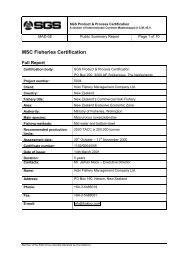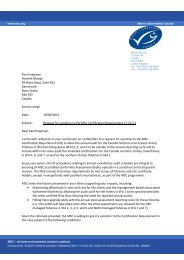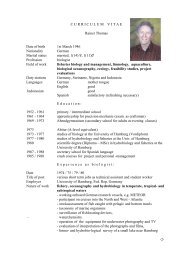SGS Product & Process Certification - Marine Stewardship Council
SGS Product & Process Certification - Marine Stewardship Council
SGS Product & Process Certification - Marine Stewardship Council
Create successful ePaper yourself
Turn your PDF publications into a flip-book with our unique Google optimized e-Paper software.
This is, in the main, a competent and comprehensive assessment of the Dutch rod and line fishery for Sea Bass against the MSC Principles and Criteria<br />
for Sustainable Fisheries. The Report provides an authoritative overview of the fishery and the issues that relate to the three MSC Principles. I concur<br />
with the majority of comments and scoring in the Report, though I have serious concerns about the overall score for Principle 1 and the use of the Risk<br />
Based Framework (RBF).<br />
Inevitably the majority of my comments relate to P1. This is not a reflection on the competence of the P1 assessor, but a consequence of dealing on<br />
the one hand with a relatively data-poor fishery, and on the other hand, one which has very little environmental impact and takes place within a welldeveloped<br />
fishery management regime.<br />
The client rod and line fishery is relatively small scale and has a desirable exploitation pattern. It is the type of fishery that should be encouraged and<br />
would be expected to meet the MSC Principles and Criteria for Sustainable Fisheries. However, this assessment has to look at the total exploitation on<br />
bass within the unit of certification. It is clear that there are extensive landings from other commercial fisheries (French mid-water trawling (not in the<br />
North Sea), and Dutch beam-trawl, fly-seine and twin-rig trawl gears) and from the large Dutch recreational fishery. There appear to be warning signs of<br />
declining landings and mean size (these are anecdotal and from recreational anglers, who have a well declared vested interest in sea bass fisheries)<br />
that raise serious concerns about the impact of trawling with its undesirable exploitation pattern. In my view this assessment has failed to evaluate the<br />
impact of these other fisheries at a level sufficient to convince that the southern North Sea bass stock is being exploited in a medium-term sustainable<br />
manner. On that basis, unfortunately, I have concluded that this fishery should not be certified at this time. The assessment team has amended the<br />
report to better substantiate the case for certification, see below.<br />
2.1 Biology of the target species. There is a need to be a bit more definite about the current biological stock identity in the certification area. Do<br />
we have a ―biologically distinct unit‖? Are there links with the English Channel? If yes, then has the exploitation in the Channel been taken into account<br />
when assessing the state of the ―stock‖ in the southern North Sea?<br />
What is known about the sea bass population in the North Sea and its connections with other areas is clearly spelt out in the report (and is the subject of<br />
more refereed publications than for most other species‘ ―stocks‖ in NW European waters), and exploitation of the North Sea-English Channel stock unit<br />
outside the area fished by the UoC is implicitly taken into account in the assessments.<br />
2.2.1 History of the fishery. Can the landings data by country in Table 1 be split into IVc and VIId? No, and exploitation in VIId is relevant to stock<br />
dynamics in the North Sea, see above. The French and Dutch exploitation by trawl in IVc has potentially serious implications for the southern North Sea<br />
―stock‖. Are the landings excluding or including recreational fishing? Quote ―Dutch recreational landings of sea bass in 2006 were estimated at 195 t<br />
(Kroon, 2007).‖ Are these included in Table 1? Table 1 presents commercial landings only. It is acknowledged that recreational catches of sea bass<br />
must have some impact on exploitation levels, but overall mortality is reflected in the catch-at-age data series that have been used in assessments.<br />
Page 123 of 151





